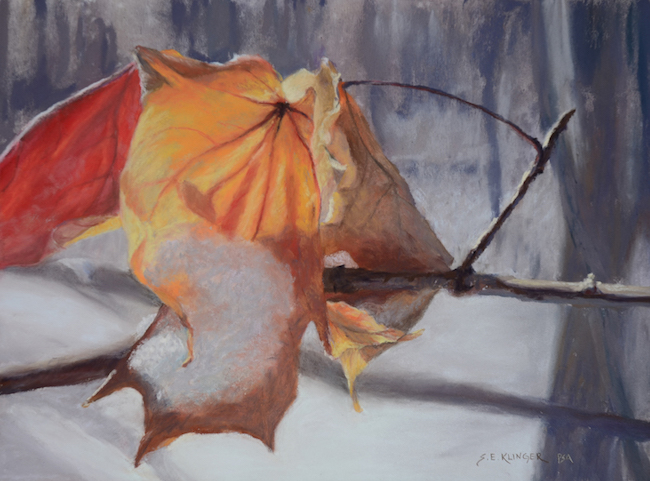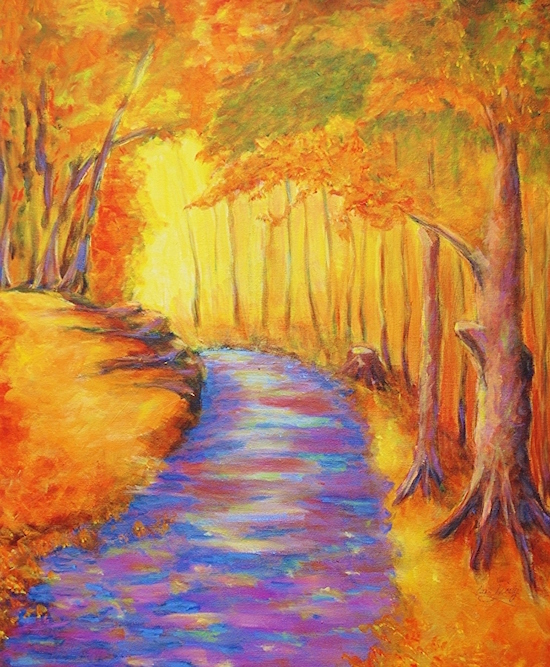Art buyers often have as many insecurities about the process of buying art as you do, which means they are sensitive to the signals you’re sending.
It’s your job to reassure them that they are making the right decisions – and you can do so in very subtle ways without resorting to sales speak.
And it has just as much to do with what you don’t do and say.

Here are seven practices that might be scaring off your audience and potential fans.
1. Being indecisive about prices.
Indecision makes you appear less confident.
Set your prices after you’ve done your homework and be ready to share them in person and online.
If you’re ever pushed for a price that you aren’t certain about, say, “Let me check my list and get back to you. I wouldn’t want to give you the wrong price.”
2. Apologizing for your art.
The apologetic artist who brushes aside compliments about her art is not market-attractive.
I am not in any way condoning arrogance. I’m saying that you need to hold your head up and say “Thank You” when you are given a compliment.
As Julia Child said in Julie & Julia, “Never apologize. No excuses. No explanations.” Along the same lines . . .
3. Playing down the fact that you’re an artist.
Heart surgeons don’t look at the ground and say, “I’m kind of a heart surgeon.” When someone asks what you do, you shouldn’t respond meekly with, “Well, I’m kind of an artist.”

You’re an artist or you’re not. There’s no “kind of” about it.
Embrace it. Practice it. Live it.
4. Stammering when someone asks you about your work.
No one knows your art better than you. When you are given the chance to tell someone about your work, you must be able to speak intelligently. After all, who else would they turn to?
You don’t have to be well versed in all of art history, but you’ve got to know about your work. You should be able to address your materials, subjects, style, and how you fit in your art market.
To gain some vocabulary, read what other artists say about their art and watch them on videos. Plus check out my Magnetic You program that teaches how to speak and write effectively about your work.
5. Having an outdated website.
Your website is often the first place people will see your art. It should be a priority, not an afterthought.
This means it must look like it was created recently rather than 5 or more years ago. And make sure to update the content regularly.
6. Hiding your social media links.
Do you want people to follow you on social media? Then for Pete’s sake make it easy to find your social media links.

It used to be that it was okay for social links to be on only one page – like an About page. But who has time to poke around and find them? Make sure they’re visible on every page of your site.
7. Sending a bulk email after not being in touch with your list for over a year.
As I have shared before, the main purpose of an artist’s newsletter is to keep the list warm.
People signed up for your list because they want to hear from you.
If you don’t send regular(ish) updates, you can’t suddenly expect action from your connections.



38 thoughts on “7 Ways You Might Be Scaring Off Potential Buyers”
Thank you Alyson for the most helpful blog an artist could ever find. Every post is a gem.
Do you think artists should add clickable social media buttons to their email signatures, websites, etc.? If so, could you instruct us on how to do this in a future blog.
Linda: Thanks for being here! I tend to think there should only be one link in an email signature (for spam reasons and just to funnel people) and that it shouldn’t be your home page. If you have done your job well linking all of your sites, everything should be easy to find no matter where you send people.
Alyson, if the link shouldn’t be my homepage, what should it be? Thanks so much for your blog; of all the people giving artist advice, you are the best!
Jane: Almost any other page on an artist’s site is more interesting than a home page. Your About page? Blog (only if you use it!), portfolio, news, most recent work.
And, you’e welcome. Thanks for being here and reading.
hi Alyson-
I would suggest that it is good for an artist to build their own website. This gives complete control over adding and changing any elements. It is very easy to do, no code necessary, just a basic understanding of cut and paste. The worst is to have an out dated website- which if you are an artist creating will happen very quickly.
Kara: We have another opinion coming up November 1 from an artist who spent 100 hours making her own site.
I have seen SO many artist-built sites that are horrible, that I can’t agree with this 100%.
hi Alyson-
In all honesty 100 hours is not much time at all, especially if You want to be good at something or want to create something worthwhile. It has never been easier to utilize all the tech tools available to us. I have seen far many more badly designed and out of date websites built by someone else, who is not the artist.
Creating an attractive and functional website is doable with all the resources available but it is time consuming and 100 hours is a starting point. While a techie can assist with some tasks, only the artist can generate descriptions and keywords which resonate with an audience. Only the artist can determine what their branding should say and only the artist can determine which products to present and how best to present them. Thus, there are really no shortcuts to developing and managing your website.
Leah: I disagree a little in that I believe you should hire help to make sure it functions properly.
Yesterday I asked my college art professor what he charges for his pieces (he is represented by 2 fine art galleries and he will be in SOFA for the first time this year.) He responded with the question, “Why do you want to know?” I said because I may want to buy a piece. He finally admitted the gallery sells his pieces for $1000-$5000. I was seriously considering buying a piece and could have afforded one in the the lower end of the range. I was offended about the fact that he didn’t want to reveal his prices even AFTER I said that I might want to buy one, like I was trying to find out some kind of proprietary information. There were a few other students there during this conversation, as well, and I could tell they were curious also.
Needless to say, his responses to that and other questions offended me so much that I no longer want to buy one of his pieces, which is too bad for both of us and the gallery. He seriously came across to me like I wasn’t good enough to buy his art. And I’ve also lost respect for him as a teacher.
M: I have heard quite a few stories about how secretive art profs are. It’s such a shame and so silly.
I like to collect student work, though they don’t make it easy. They are not taught about the mundane & dirty business of art, and have no idea about pricing, and often even talking about their work outside the class critiques. When I taught a semester-length class in book arts, I made this one of the foci of the class, including having them jury their own work and then later on a local exhibit open to entries from the public. I also showed them examples of works by established book artists and shared the pricing information…
Truth be told, I also often find student work much more interesting than faculty work, something that has been reinforced by going to events at the universities I’ve worked at that all have strong art programs.
Good for you for buying student work, Peter. And for teaching your own students.
In defense of the professor, it may have been uncomfortable to be asked his prices without knowing why you were asking, especially if other students were around and clearly listening. It’s like someone asking your salary. If I’m interested in buying a piece from a teacher or any artist for that matter, I’ll come right out and say “I’m interested in possibly buying a piece from you. Can you tell me your price range?” I also keep the conversation private. Just my .02, but I would not want to be asked about my prices in front of a group of people, especially if they were my students.
Here’s another one…make sure when you click “contact” on your website that it actually gives or takes you to an address. When I couldn’t contact the artist that way, I went on FB and wrote her an email…never heard back! Oh well…lost sale!
Kathryn: I always say that you should provide at least 2 ways to get a hold of you. And I think 1 of them should be a phone number. (but I also like seeing a physical address)
Last Summer when I could have sold one more painting, I talked my potential collector out of a piece by presenting her my honest opinion that it was not the kind of piece that should be hung in her house or any house for that matter. The painting she was interested in purchasing was on some dark subjects (depicting 9/11 event, tombstone of a little girl killed by a pedophile and family that was killed in an automobile accident). I told her that it was a better fit for a museum but not for a warm cozy home. I usually paint cheerful and uplifting conceptual paintings and even though my painting looked bright and colorful on surface, I just did not feel right selling her something morbid that emanated negative vibes. She excused herself and spoke to her partner about it and they both approached me few minutes later, thanked me for being honest and promised that they will definitely purchase a painting out of my new batch at my next show. They still keep in touch with me quite regularly and even though I lost $250 worth of sale, it just felt right to educate them what the painting was about. I may have lost a sale, but I believe I have gained a friend and a collector who feels confidant that I am not out to make a quick buck.
Roopa: You clearly did the right thing. I suppose you would preface the conversation with, “I’m so happy you like my work enough to buy it. Would you mind if I share a little about this piece – just to make sure it’s right for you?”
Yes, I will do that next time if the need arises. I usually do not create paintings that evoke negative emotions so that is usually not an issue. However, now I know how to word it right. Thank you Alyson!
I found your site to be very helpful. None of my teachers ever mentioned this sort of thing, even though they knew I was doing art shows. Perhaps they didn’t know. I will no longer apologize, I will have my pricing readily available and will try not to be afraid of pricing. I do need to read more about my “list”. Since I don’t really have one,
I’m happy you found it helpful, Phyllis.
What great advice! Very valuable, thank you.
Thanks for reading, Alexandra.
I’m constantly amazed how the ability to stand up and say “I’m an artist” without any qualifiers is completely unrelated to how good the artist’s work is. I’ve seen artists who I would consider ‘beginners’ boldly state their status while incredibly talented and experienced artists are looking at their feet and saying “I’m not a real artist but…”.
I think so often we believe we’re ‘not there yet’ as artists because what we seek is to be ‘great’ and we are in awe of how much there is still to learn…That humility is part of what makes us constantly seek to improve but it’s certainly a downfall at the moment of selling our work!
Cherry: Yes! In my experience, it’s those who are more established who know that their journey is really just beginning.
Thank you Alyson, some of this was like you were addressing me.
I am getting better about meeting admires of my work and I agree with Cherry for the reasons of
being more quiet.
I’ll get there some day.
I would add “yakking your potential customer’s ear off” to this great list. I have experienced this, and have been guilty of this myself. I think we get so excited (or nervous) that someone is interested in our art that we forget to give them space to really look at the art and think about it. When I first opened my studio, I noticed people would be enthusiastic about my work, would seem to have honed in on something of interest, but then they’d leave without buying anything. I started paying more attention to what I was doing and realized that I was interrupting their decision-making process with my conversation. I noticed that all of my in-person sales were happening after I had an initial friendly conversation with them and then allowed them time to look around. So now I’m very careful not to overdo the talking, and my sales have improved.
Alyson,
7 points not to scare clients not only an affirmative point but rarely addressed. Had to share
Thx. Great post
Vicki P Maguire
Good one, Gabrielle.
Thank you so much for this insightful blog post. I must make sure to review it again to ensure I’m not frightful to my fans and clients.
Antonia: I can’t imagine you’d be guilty of any of these.
Fantastic post. Subject never
Approached like this and yet affirmative. Thx. Vicki
Will share????
Thanks for sharing, Vicki.
Alyson, thanks for the valuable points as also that of other artists. Gabrielle’s thoughts are in sync with mine! Have shared my website here. Your thoughts are welcome!
Every year the same woman writes to me about the same sculpture. This year, Year #5, she asked if I would give her a discount on the $1600 price—because she has wanted it for so long! Her FB page shows her luxuriating with her family on a luxurious island vacation! I responded that while I don’t discount my work, she might want to consider a Payment Plan. There was no response.
Your articles are right on target and I always share you on my FB pages.
Thank you, Alice. I appreciate this.
Good for you for sticking to your principles.
Thanks for these reminders, Allyson. I have a good sized mailing list, and I send out newsletters maybe, every few months when I have some things to share. This was a HUGE step for me in my promotional efforts. Despite this, I still always have the sense that I am “intruding” on people by sending them information. I would love to know your thoughts on this, and also, how often should artists be in contact with their “list”? Do you think that more regular contact is better than sporadic?
Thanks so much!
Linda
Yes, I do. And I think it’s a good practice to be in – stretches you and helps you grow.
To begin, could you start with bi-monthly and commit to that?